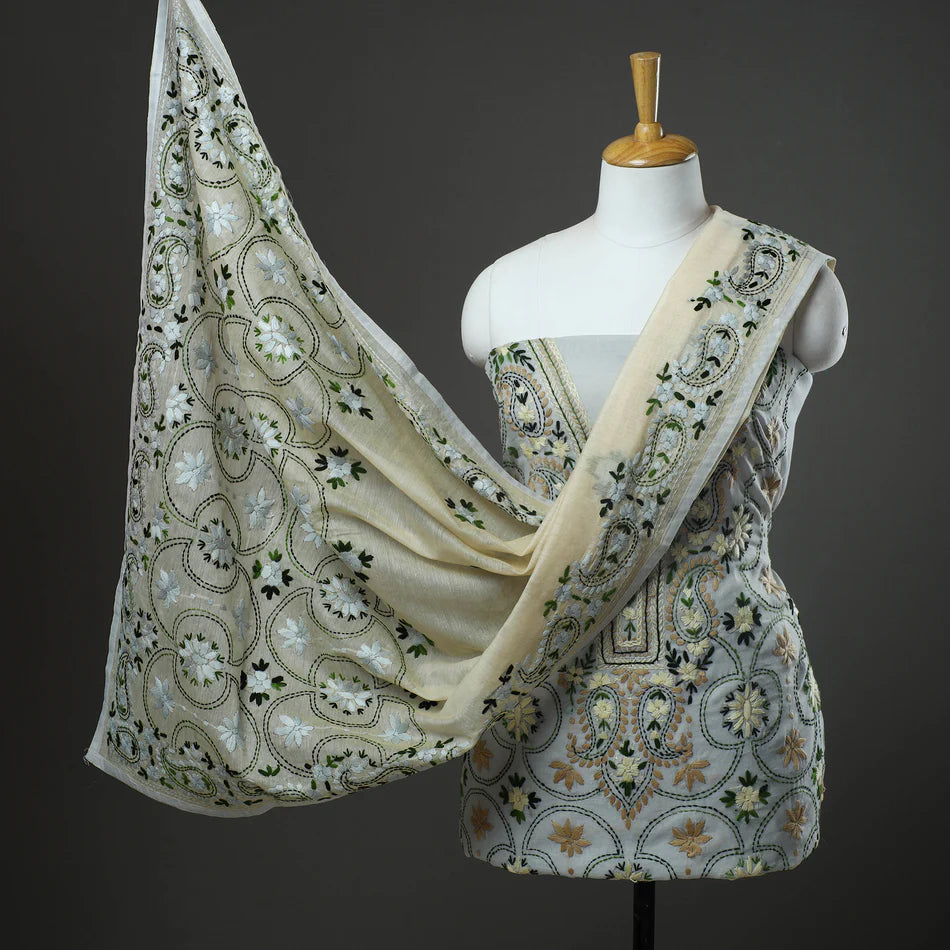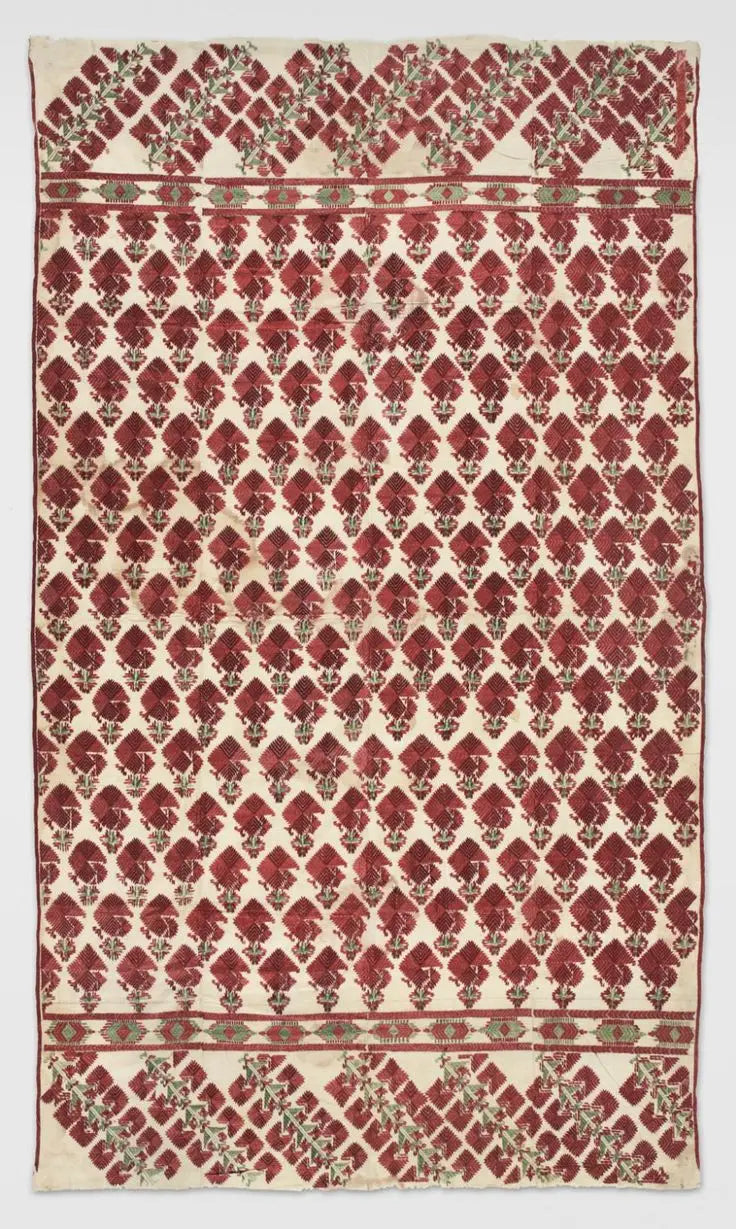India is a nation with undeniably rich historical, cultural, and traditional roots that are clearly visible in its contemporary social milieu as well. The craftsman that hail from various regions of the nation pass on their exceptional handloom, hand-embroidery, and handicraft among others deftly impart skills to the younger generations so the art form can survive and families pursue them dedicatedly.
One popular embroidery technique in India is the Phulkari embroidery, which has its origins in the northern state of Punjab. In this article, we will talk about the exquisite Punjabi Phulkari, its history, types, and current market.
What Is Phulkari Embroidery?
The traditional embroidery is called phulkari, because of the tricky flower designs used as motifs. Phulkari literally translates as ‘flower work.’
Phulkari embroidery has been practised widely by the women of the region and continues to be an example of the great heritage of the Punjab region.

Origin Of Phulkari Embroidery
Phulkari is a style of embroidery that has its origins in the state of Punjab, India. Initially, it was the womenfolk who worked with bright colourful thread strands to create beautiful flower motifs on cotton fabrics. The earliest references to the phulkari embroidery designs can be found in a famous literary creation of the 18th century in Punjabi, ‘Heer Ranjha’.
Initially considered an outlet for women’s creative expression, Phulkari fabric has today become representative of the vibrant and lively culture of Punjab. The embroidery form is unique and colourful, and its intricate designs are bewitching just like the culture of the Sikhs.
Phulkari Embroidery Designs: Motifs Used
The motifs used in the different types of phulkari embroidery mainly comprise flowers, geometric shapes, animals, etc. As is evident, phulkari artists take creative inspiration from nature.
The speciality of these motifs is that they are embroidered by employing the 'darning stitch', a technique of stitching that involves decorating the fabric with various shapes, and lines, which in turn are filled with detailed- carefully done running stitches to create a neat, condensed, and textured pattern.
Materials Required For Phulkari Embroidery
The materials required to do phulkari embroidery are easily available. A plain cotton fabric is used as the base material on which the patterns are embroidered. The other element is the silk threads used in making the designs on the cotton cloth.
Both of these raw materials can be found conveniently and sourced locally, especially in places where there is demand for the materials. Silk thread and cotton fabric can be dyed as per the need and occasion.
Types of Phulkari Embroidery
Thirma Phulkari
Thirma phulkari is a type of embroidery that is done on white, or off-white cloth. The designs are simple and sophisticated. The Thirma embroidery which is native to present-day Pakistan is often used to create attires for the older women/ widows. Other products like bedsheets and curtains also employ this type of phulkari embroidery.

Image Credit: pintrest
Chope Phulkari
One famous type is that of Chope Phulkari embroidery designs, it uses geometric patterns and a deft craftsperson is required for its right execution. The motifs are usually included in the borders and this type of dupatta is given to the bride by her grandmother before the wedding ceremony. This embroidery is mostly done with silk threads on a cotton base. Chope phulkari is a popular choice for scarves, shawls, etc.

Image Credit: MAP Academy
Suber Phulkari
Very similar to the Chope phulkari form, the Suber phulkari was also traditionally gifted to the bride by her maternal grandmother. The ritual was for the bride to donne this gift for her wedding ‘pheras.’ This type of embroidery carefully uses many hues to create harmony in a riot of colours and makes use of vibrant silk threads to create motifs on cotton fabric.

Image Credit: MAP Academy
Some other stictches of Phulkari include
- Vari Da Bagh Phulkari or Vari Da Bagh
- Dasharn Dwar Phulkari
- Sainchi Phulkari
- Til Patra Phulkari
Punjabi Phulkari In Present Day
Phulkari is widely popular across the world today. From Phulkari dupattas to Phulkari cushion covers you can find these beautiful embroideries in a variety of products.
Numerous designers across the world have incorporated Punjabi phulkari into their works. The versatile, colourful, and timeless designs have become part of the mainstream choice in traditional, and fusion-wear clothing lines.
Conclusion
To conclude, we’d like to stress that phulkari is a significant part of the vibrant culture and heritage of the Punjab region. With its contemporary popularity, it has become a highly cherished commodity in many women’s wardrobes.
If you’re looking for a versatile saree, scarf, or shawl, and do not already have phulkari items in your cupboard, you’re missing out. Get yourself clothes with Phulkari embroidery designs and enjoy adding colours to your daily wear.
FAQs on Phulkari Embroidery
How many types of Phulkari are there?
There are many varieties of Phulkari embroidery. The most famous ones include- Thirma, Bagh, Chope, Tilpatra, Dwar, Ghunghat, Sainchi, etc. Traditionally, hand-made khaddi was used as the base fabric to create different types of embroidery, however, today
What are the interesting facts about Phulkari embroidery?
The fact that various Phulkari embroidery designs have their origin in Punjab, is no surprise. What may be of interest to you, is that traditionally phulkari work was only done by women of the Punjab region. Another fact that may intrigue you is that phulkari was originally not made for sale but as gifts to be circulated in the family or among friends, and relatives.
What is the Speciality of Phulkari embroidery?
What’s special about phulkari is that simple raw materials like silk threads, cotton fabric, and the use of straightforward running stitch, results in beautifully adorned finished products. The skilled phulkari craftsmen ensure that intricate colourful designs are carefully woven into the fabric.
Phulkari embroidery is from which state?
Phulkari embroidery is from the state of Punjab in India. It has been a part of Punjabi culture for centuries and is still widely practised in the region today. Phulkari work is also popular in the Sindh region of present-day Pakistan.
 Verified Purchase
Verified Purchase






























Leave a comment (all fields required)